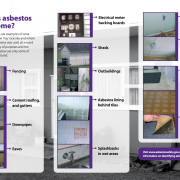About Asbestos and who it can affect?
DIY renovators
Approximately one third of all homes in Australia contain asbestos products.
If your house was built before 1990, it is likely that it would have some asbestos-containing materials. Find out more about what asbestos is and how exposure occurs.
Health risks of asbestos exposure can include life-threatening illnesses. Before renovating your home you should always carry out precautions to make sure that you keep yourself, your family and your surrounding neighbours safe.
Being able to identify and understand where you could find asbestos will give you a better idea of where asbestos could be found in your home.
However, the only way to be certain that a material or product contains asbestos is to undertake the process of asbestos sampling and testing. If in doubt, treat the material as if it contains asbestos until it has been confirmed otherwise.
If you are unsure whether or not your house contains asbestos, you should consider getting an asbestos inspection. An asbestos survey will tell you if asbestos is present and if any further action is needed to manage the risk of the asbestos.
It is highly recommended that you get an asbestos survey before hiring any tradespeople and that you provide any tradespeople with a copy of the asbestos survey report before they carry out work on your home so they are aware of any potential risks.
To find a licensed asbestos assessor, you can call or visit the website of the work health and safety regulator in your state or territory.
DIY asbestos removal is not recommended and in some states is not legal. In the ACT, all asbestos removal work must be carried out by a licensed asbestos removalist.
In all other states and territories, a non-licensed person is allowed to remove non-friable asbestos as long as the area is no bigger than 10m². Ensure you read more information on DIY removal if you are a DIY home renovator thinking about removing non-friable asbestos yourself.
If you know your home contains asbestos and you want to get it removed professionally, you can call or visit the website of the work health and safety regulator in your state or territory to find a licensed asbestos removalist.
Useful resources
Real estate agents
Approximately one third of all homes in Australia contain asbestos products.
If a house was built before 1990, it is likely that it would have some asbestos-containing materials. Ensure you read more information on where you could find asbestos to give you a better understanding of the most common areas of where asbestos could be found in residential properties.
As a property manager, you should be aware if the house you are responsible for contains asbestos so that you can take the right precautions to protect yourself and your tenants/ potential buyers.
It is highly recommended that all property managers or homeowners get an asbestos survey of their property to identify if asbestos is present and if it needs to be managed or removed. Read more about getting an asbestos inspection and what to expect from the process.
If you hire any tradespeople to carry out work on the property, you should always provide them with a copy of the asbestos survey report before the work begins.
If you know the property contains asbestos and you want to get it removed professionally, you should hire a licensed asbestos removalist.
Useful resources
Work health and safety regulator in your state or territory – to find a licensed asbestos assessor or licensed asbestos removalist in your state or territory.
Safe Work Australia’s model Code of Practice – how to manage and control asbestos in the workplace, for practical guidance on how to manage risks associated with asbestos, and asbestos-containing materials.
Tradespeople
Construction and maintenance workers face the highest risk of disturbing asbestos-containing materials and breathing in deadly asbestos fibres. Because of this, tradespeople are the most likely group of people to be diagnosed with an asbestos-related disease.
Before starting any job, you should always be aware if asbestos is present so that you can take the right precautions to protect yourself and your families – who could inhale asbestos fibres that might be stuck to your clothes.
One third of all buildings in Australia contain asbestos products. If you are working on a building or structure that was built before 1990, it is likely that it would have some asbestos-containing materials (ACMs).
Commercial buildings built before 31 December 2003 should have an asbestos register. An asbestos register is a document that lists all identified (or assumed) asbestos in a workplace. You should always make sure that you have seen a copy of a current asbestos register before starting any construction or maintenance work. If you think that the work you are about to do will disturb asbestos, you should talk to the person with management or control of the workplace, or alternatively, your health and safety representative.
Similarly, if you are working on a residential property, homeowners are advised to have an asbestos survey of their home, and they should provide tradespeople with the asbestos survey report before any work begins.
It is also important to note that DIY/unlicensed asbestos removal is not recommended and in some states is not legal. In the ACT, all asbestos removal work must be carried out by a licensed asbestos removalist.
In all other states and territories, a ‘competent person’ is allowed to remove non-friable asbestos as long as the area is no bigger than 10m². For more information on removing less than 10m² of non-friable asbestos, you can visit the DIY removal pages.
Whatever the circumstance is, make sure you have at least undertaken appropriate asbestos awareness training so that you can identify asbestos risks at work.
Useful resources
Work health and safety regulator in your state or territory – for specific rules, regulations and guidance that could apply to you and the job you are working on.
Safe Work Australia model Code of Practice on how to manage and control asbestos in the workplace – for practical guidance on how to manage risks associated with asbestos and asbestos-containing materials.
www.training.gov.au – for asbestos awareness and training courses and to find a training provider.
Asbestos awareness information for the general construction industry



